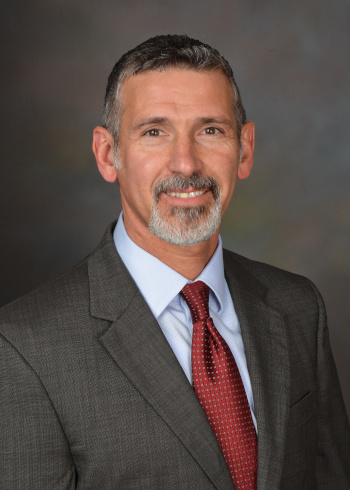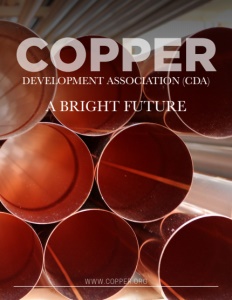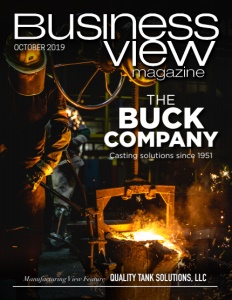The Copper Development Association
A bright future
Business View Magazine interviews Thom Passek, President of the Copper Development Association, as part of our focus on use of metals for business and industry.
Copper, a chemical element with the symbol Cu (from Latin: cuprum) and atomic #29, is one of the few metals that can occur in nature in a directly usable form. This led to very early human use in several regions around the world. In fact, the known history of copper use dates back to 9000 BC in the Middle East. Thousands of years later, c. 5000 BC, it was the first metal to be smelted from sulfide ores; the first metal to be cast into a shape in a mold, c. 4000 BC; and the first metal to be purposefully alloyed with another metal, tin, to create bronze, c. 3500 BC.
Today, the major applications of copper are electrical wire (60%), roofing and plumbing (20%), and industrial machinery (15%). Copper is used mostly as a pure metal, but when greater hardness is required, it is put into such alloys as brass and bronze (5% of total use). For more than two centuries, copper paint has been used on boat hulls to control the growth of plants and shellfish. A small part of the copper supply is also used for nutritional supplements and fungicides in agriculture.
The Copper Development Association Inc. (CDA) is a U.S-based, not-for-profit association of the global copper industry, influencing the use of copper and copper alloys through research, development, and education, as well as technical and end-user support. CDA is committed to promoting the proper use of copper materials in sustainable, efficient applications for business, industry, and the home.

Thom Passek, President
“The organization was founded in 1963,” says CDA President, Thom Passek. “It was established to bridge the gap between companies that mined copper, fabricated copper products, or marketed copper and copper alloys to those that produce a myriad of applications. It was really created to help grow interest in, and demand for, copper and copper alloy products. That hasn’t changed over the 50-plus years that we’ve been in existence. It still brings together the copper producers, copper fabricators, and the users of copper with the essential goal of promoting and growing the use of copper.”
“Our mission is to influence the use of copper and copper alloys through market research, technical research, market development and education, as well as technical and end-user support,” Passek continues. “So, we’re going out and supporting our members’ customers’ customers. Our vision is to promote the goals of our members, while serving the needs of the users, purchasers, designers, and special buyers of copper and copper alloys. So, we’re out there, positively influencing the use of copper and its alloys in the marketplace. We develop and share scientifically sound knowledge related to the production and use of copper and copper alloys; we support and promote technologies, systems, and applications in which copper materials play a role; and we encourage both corporate and environmental responsibility in the process.”
The membership of the CDA is comprised, primarily, of some 60 companies throughout the United States and Canada that are copper fabricators of: sheet, strip and plate; tube and fittings; rod and bar; and wire and cable. “We also have a connection with the copper miners in North America, as well,” Passek adds. “There are different tiers of membership. To be a full member, you either have to produce copper at the mine, or produce a fabricated copper product in North America. We have associate members who either have their base of production outside of North America but may have offices in the U.S. or Canada; or they may be somebody that produces a tool that’s important to the installation of copper products; or they may produce copper end products like sinks, faucets, and things of that nature.”
Passek says that CDA members are kept apprised of the association’s work and events through its website, which has information for the general public as well as a member’s portal. “A lot of it is public facing, but if you are a member, you get access to additional information,” he explains. “We collect industry statistics on production in various forms and it’s of great importance to our fabricator members to understand imports and exports of copper products. We also have information on meetings with regulatory bodies and issues that may be of importance through the members-only site, as well.”
The CDA also holds two membership meetings a year. “We bring together our members for two days to meet with each other,” Passek reports. “We bring in some outside speakers; we have product forums, where our members will discuss issues of importance aligned with the product form that they may produce, whether it be rod and bar or wire and cable; and we identify what our priorities are for the industry and for CDA to potentially pursue, moving forward. We produce newsletters that go out periodically during the course of the year, as well.”
CDA’s staff of 20 full-time employees is augmented by a number of consultants within the various industries that the association aligns with. “We also have the benefit of being part of the Copper Alliance, which is a global organization that supports the world’s copper mines,” Passek remarks. “And with that, comes connections to other regional copper offices in Europe, Asia, and Latin America. So then, we have an outreach to a much broader staff that goes over 125, worldwide. We share technical information, research, case histories, that benefit all of our members. Everything we do is backed by science and research. We do codes and standards work to make sure copper is properly positioned; we work with regulatory bodies; we have a strong team in the area of health, environment, and sustainable development.”
Passek adds that, in addition to helping to build relationships within the copper community – producers, fabricators, recyclers, etc. – the CDA also helps tell the story of copper to a wider audience in a way that an individual company or manufacturer might not be able to do. “We do an awful lot of work with the end-user community,” he states. “For example, years ago, we had the Flint water crisis. Everybody was very interested in the potential opportunity that it might present from a business perspective, but, quite frankly, that wasn’t the right way to pursue it. My technical team of experts reached out to the City of Flint to help them address their water issue with lead service line replacements. We told them how we worked with other municipalities; we talked to them about the value of copper and its long-term durability, its reliability in delivering clean and safe water, and the fact that it has a 75-year life. Oftentimes, people will look at that initial cost model and say, ‘copper is a little bit more expensive than other materials,’ yet the lifecycle and long-term value of copper makes it a very economical solution. We worked with the City of Flint, gave them technical advice, and it ended up helping them decide that they wanted to utilize copper as a long-term solution to their issue. That’s not something, typically, that a company can do. So, we really put our experts out in the field, working with end users in helping them understand the value of copper, how it’s to be appropriately applied, and some of its economic benefits. And then, if the opportunity presents itself, we make those introductions to our various members so that they can grow their business and grow the pie for copper.”
While copper may be one of the oldest metals used by humans, Passek maintains that it’s also a 21st century material. “It’s critical for renewable energy systems – wind, solar, and hydro,” he asserts. “It also contributes to the circular economy through reuse and recycling – copper is 100 percent recyclable for its life. Copper is an important driver in the electro-mobility marketplace – there’s four times as much copper in an electric vehicle compared to an internal combustion engine. Then, you take that throughout the whole value chain – the vehicle, the charging station, the electrical grid, the energy storage systems – without copper, the whole electric mobility movement isn’t going to be as efficient or effective. It’s also anti-microbial. Copper will actually kill, on contact, 99.9 percent of germs within a two-hour period. So, it has some great benefits for public health in the area of green and healthy buildings. We see a lot of buildings going for LEED certification, and now there’s what they call WELL certification in which a building is designed for the wellness of the people that occupy it. I think there are over 140 applications of copper within them, so, copper plays an integral part in green and healthy buildings.”
“The fact is, copper makes people’s lives better,” Passek says in conclusion. “Oftentimes, they don’t see what’s behind the wall – whether it’s the plumbing, whether it’s the electrical, whether it’s the anti-microbial touch surface. We use the tagline: ‘Better Economy, Better Planet, Better Health, Better Transport, Better Buildings.’ So, the outlook for the copper industry remains solid. The future is bright as copper is, itself.”
AT A GLANCE
WHO: The Copper Development Association
WHAT: A U.S-based, not-for-profit association of the global copper industry
WHERE: Washington, DC
WEBSITE: www.copper.org


